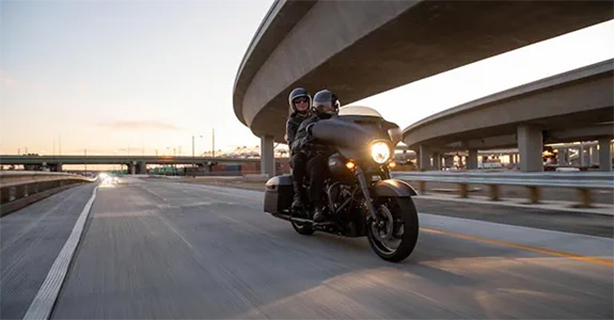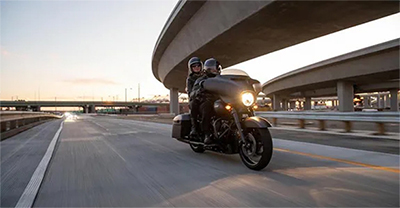Riding ‘two-up’ is one of the great simple pleasures of motorcycling, but both you and your passenger must know what you’re doing. Here are a few tips to make sure you both stay safe.
Thinking about riding two-up? Sharing the open road with a passenger can turn a solo ride into a powerful bonding experience—but only if you both know what you're doing.
If you’re wondering how two people can ride a motorcycle together safely and comfortably, this guide covers everything from prepping your motorcycle to coaching your companion.
Before you hit the ignition, make sure you’re both ready for the ride.
PREPARING YOUR MOTORCYCLE FOR CARRYING TWO PEOPLE
Before you ask a passenger to climb aboard your motorcycle, make sure your motorcycle is prepared for the experience. Some models are well-suited to carrying two people; others are less so.
But if they're adequately designed and equipped, your motorcycle can be used to carry a passenger.
Use Only Properly Designed Seating
Ensure your motorcycle is designed to carry a passenger and that a proper passenger seat is securely installed. A passenger’s seat is behind the operator/rider and passenger seating options include a one-piece seat with a two-up saddle or a solo seat paired with a pillion seat. Regardless of which type of seat you have, a secure hand-hold within your passenger’s reach is required and will be either a grab strap on the seat or a handle adjacent to the seat designed specifically for a passenger. Never allow a passenger to sit on a luggage rack, rear fender, or any non-seating surface.
Install Passenger Footpegs Or Floorboards
In certain cases, motorcycles with a single seat that initially appealed to the solo rider may also be designed to carry a passenger. If this is the case, install passenger foot supports in the factory provided installation locations designed for passenger use.
Foot supports for your passenger can be either foot pegs or floorboards with some options having additional range of location adjustment. Make sure your passenger can reach them comfortably. This is especially important for minors or shorter individuals.
Adjust Suspension for Added Load
If your plan is to carry a passenger, then adjusting your suspension for the additional load is a must. You’ll get better performance (a smoother ride and improved handling) and comfort if it’s properly adjusted to carry the heavier load. Consult your owner’s manual for details – and to make sure you don’t exceed the gross vehicle weight rating (GVWR).
Any ‘bottoming out’ you feel (or hear) or any irregularity you feel in your steering while riding is a sign that your suspension is not properly set or your motorcycle’s load is too big.
Check and Adjust Tire Pressure
Similarly, ensure your tires are properly inflated (refer to your owner's manual for specific tire pressure recommendations). Depending on your riding conditions and your environment, the additional load in carrying a passenger may require you to adjust your tire pressure accordingly.
Remember: Under-inflation can adversely affect handling, reduce fuel mileage, and decrease tire life. Over-inflation, on the other hand, can reduce traction, lead to uneven tire wear, and create a harsher ride, potentially increasing the risk of tire damage or failure.
Realign Your Motorcycle's Headlamp
One factor that's often overlooked is the headlamp. That extra load on your motorcycle can affect your headlamp aim by causing your motorcycle to sit slightly lower in the rear than usual.
To check, sit on your motorcycle with your passenger on the back and have someone else check the aim. Then make adjustments as necessary.
PREPARING YOUR PASSENGER TO RIDE TWO-UP
If your passenger has never ridden on the back of a motorcycle, chances are they will need more education than you will.
Proper Motorcycle Gear And Helmet Laws
The first thing you’ll want to talk about is proper attire. Your passenger needs full riding gear. An approved helmet, long pants, over-the-ankle shoes or boots, proper eye protection, a long-sleeve shirt or jacket and gloves are all recommended. Regarding helmets, ensure you are aware of the local motorcycle laws.
Most states have specific regulations for minors riding as motorcycle passengers, typically requiring the minor to wear an approved helmet and proper eye protection, as well as being able to comfortably reach the factory-installed passenger footpegs without modifications. This means you cannot attach blocks, extensions, or other alterations to help your child’s feet reach.
Lastly, avoid loose clothing or accessories that can snag on the motorcycle.
Identify “Hot Zones” to Avoid Burns
Educate your passenger by walking around the motorcycle and point to the parts which may get hot while the motorcycle is running. These areas typically include engine or exhaust components.
Instruct your passenger to avoid contacting these components while in the passenger seat and provide tips on how to avoid contact while mounting or dismounting the motorcycle and on protective gear.
Teach Them How To Get On And Off The Motorcycle Safely
It’s typically recommended that the rider is on the motorcycle upright with both feet on the ground and the front brake applied as the passenger mounts and dismounts the motorcycle. The passenger should use only the pegs or floorboards and wait for your signal before getting on or off.
Properly Holding In While Riding
Next, instruct your passenger on how to hold on properly. While sitting forward but without crowding you, have them hold on to your hips or waist or use the passenger hand-holds. This makes it easier for you both to move as one with the motorcycle.
Explain Turning Dynamics and Shifting Weight On Turns
Instruct your passenger not to lean independently. Let the motorcycle do the leaning. A good technique: have them look over your shoulder in the direction of the turn.
Preparing For Stopping And Starting
As much as possible, alert your passenger before stopping and starting, so they can brace for the change in momentum. Make sure they know to keep their feet on the foot pegs or floorboards when you come to a stop, and to sit relatively still.
If not a rider, they may not understand that the motorcycle is harder to control when stopped than it is at speed. Remind them not to put their foot down when the motorcycle stops. When starting from a stop, tell them to lean forward slightly as you accelerate.
Anticipate Bumps Together
Likewise, try to warn your passenger before you hit a bump in the road. Instruct them to shift their weight from “seat to feet” so that the legs, rather than the spine, can absorb some of the potential impact.
Establish a Passenger Communication Plan
Keep in mind, however, that your passenger may have trouble hearing you. If you don’t have a helmet comm system, agree on hand signals or taps. Turn your head to the side and slightly back when talking to your passenger, and raise your voice.
PREPARING YOURSELF FOR COMPANION RIDING
Once you've properly instructed your passenger in the nuances of riding on the back, your job is much easier.
Expect Different Handling
If it helps, think of your passenger as just another load. The same rules apply. Remember that a heavier load will decrease your ability to slow down and speed up quickly, and this effect is more pronounced on smaller motorcycles.
Low-speed maneuvering is where you’ll feel the difference most keenly, so it’s essential to do as much as possible without the passenger on board.
Slow Down And Provide For More Reaction Time
Once on the road, it's a good idea to ride a little slower overall and to be especially aware of the need to start or stop quickly. At intersections, wait for larger gaps in traffic when crossing the road, turning or merging. Also, maintain a larger space cushion around your motorcycle when riding in traffic or passing another vehicle.
Practice, Practice, Practice
Finally, be comfortable and confident before embarking on a long two-up trip or taking to the streets for the first time.
Find an empty car park where you and your passenger can practice riding together, or simply stick to side streets and low-traffic areas while developing your confidence.
Know Your Insurance Coverage
Before taking regular two-up rides, review your motorcycle insurance policy. Some insurers require you to declare regular passengers or offer specific coverage for them.
Make sure your plan includes medical payments, uninsured motorist protection, and reimbursement for your passenger’s gear in the event of an insurance incident.
PRO TIPS FOR TWO-UP RIDING SAFETY
Preload your rear brake during stops to improve stability with a passenger.
Use helmet taps or hand squeezes as basic communication signals.
Review and rehearse what to do in an emergency or unexpected stop.
THE BOTTOM LINE ON RIDING TWO-UP
Riding two-up isn’t just about transportation—it’s about connection. When both rider and passenger understand their roles, riding together becomes smooth, safe, and seriously enjoyable.
Whether you’re teaching someone new or sharing the ride with a seasoned passenger, following these tips ensures you both get the most out of the journey. Now that you know how two people can ride a motorcycle together, all that’s left is to gear up and get going.
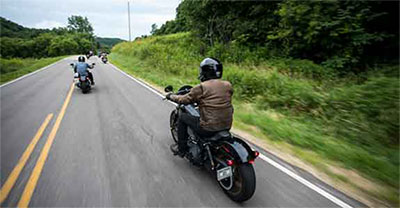
Choosing the right motorcycle insurance can be a daunting task—it needs to fit your needs and your lifestyle. Here's what you need to know!
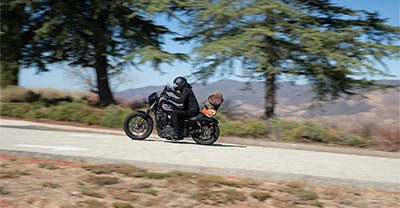
Motorcyclists relish feeling the wind in their faces. But wind can also have a treacherous side. These tips can help you anticipate and adequately react to windy conditions.
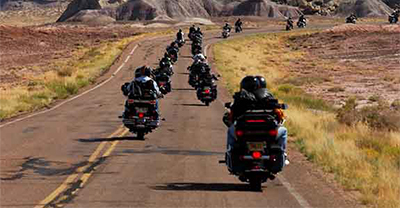
Riding in a group presents special challenges. These basic guidelines and group riding tips can help make sure your next outing is safe and enjoyable for all.

